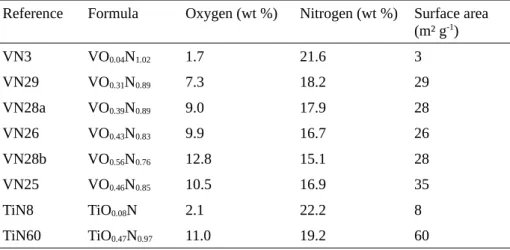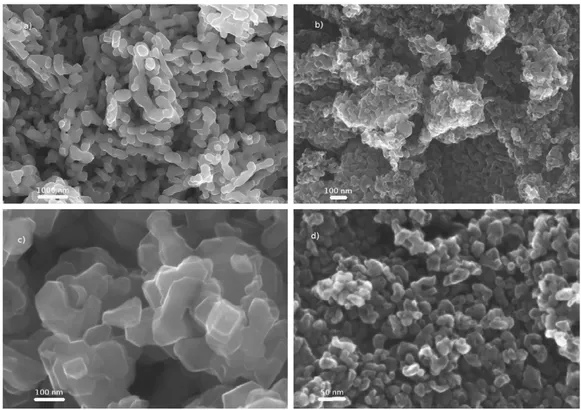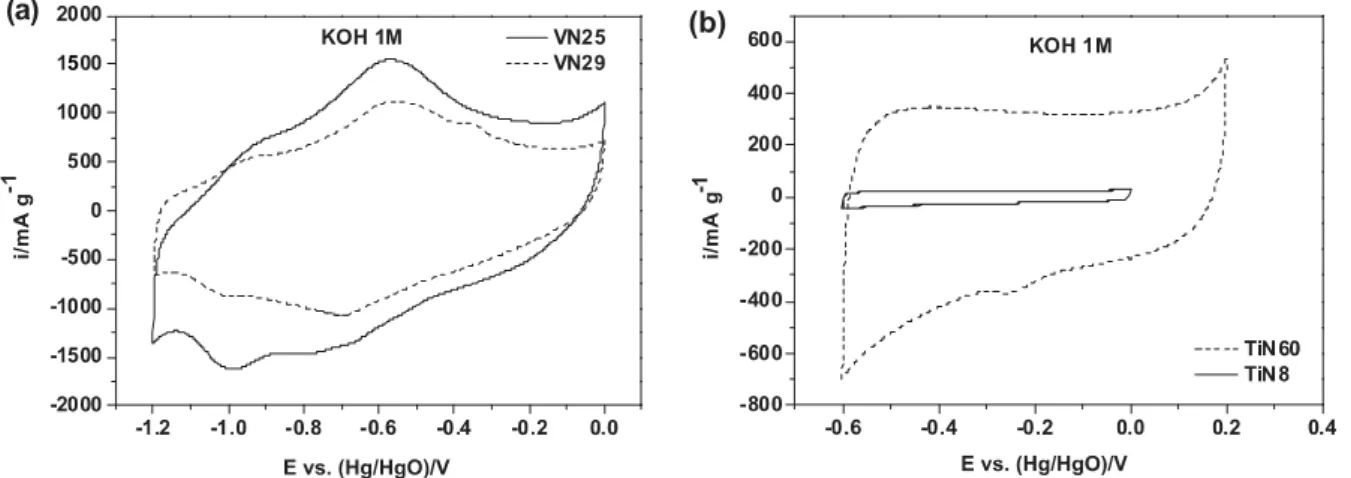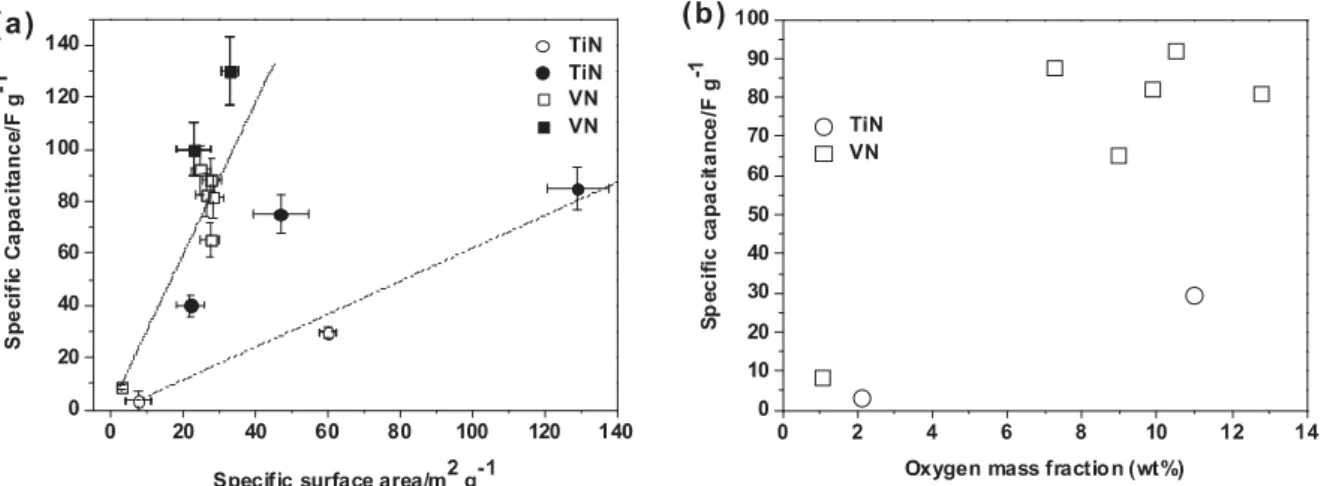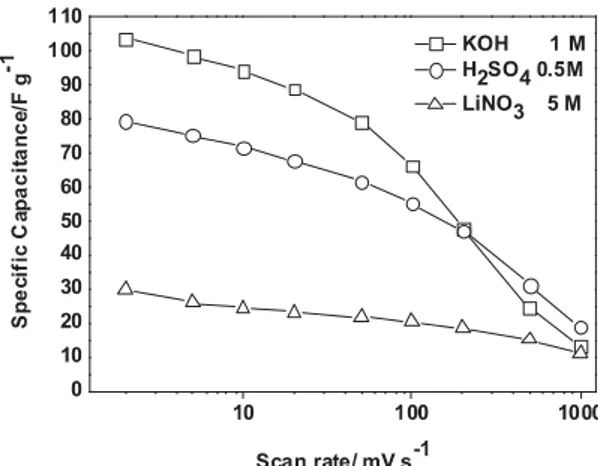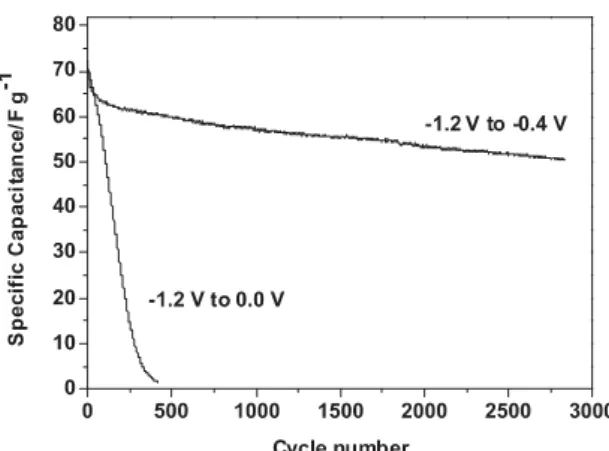HAL Id: hal-00848809
https://hal.archives-ouvertes.fr/hal-00848809
Submitted on 17 Nov 2020HAL is a multi-disciplinary open access
archive for the deposit and dissemination of sci-entific research documents, whether they are pub-lished or not. The documents may come from teaching and research institutions in France or abroad, or from public or private research centers.
L’archive ouverte pluridisciplinaire HAL, est destinée au dépôt et à la diffusion de documents scientifiques de niveau recherche, publiés ou non, émanant des établissements d’enseignement et de recherche français ou étrangers, des laboratoires publics ou privés.
Titanium and vanadium oxynitride powders as
pseudo-capacitive materials for electrochemical
capacitors
R. Lucio Porto, R. Frappier, J.B. Ducros, C. Aucher, H. Mosqueda, Sébastien
Chenu, B. Chavillon, Franck Tessier, François Cheviré
To cite this version:
R. Lucio Porto, R. Frappier, J.B. Ducros, C. Aucher, H. Mosqueda, et al.. Titanium and vanadium oxynitride powders as pseudo-capacitive materials for electrochemical capacitors. Electrochimica Acta, Elsevier, 2012, 82, pp.257-262. �10.1016/j.electacta.2012.05.032�. �hal-00848809�
Titanium and vanadium oxynitride powders as pseudo-capacitive materials for
electrochemical capacitors
R. Lucio Porto
a, R. Frappier
a, J.B. Ducros
a, C. Aucher
a, H. Mosqueda
a, S. Chenu
b, B.
Chavillon
b, F. Tessier
b, F. Cheviré
b, T. Brousse
a,∗a Institut des Matériaux Jean Rouxel (IMN), Université de Nantes, CNRS, 2 rue de la Houssinière, BP32229, 44322 Nantes Cedex 3, France b Sciences Chimiques de Rennes – équipe Verres et Céramiques, UMR CNRS 6226, 242 avenue du Général Leclerc, campus de Beaulieu, 35042 Rennes Cedex, France
* E-mail address: Thierry.brousse@univ-nantes.fr
ABSTRACT : TiOxNy and VOxNy powders have been synthesized using oxide precursors and a conventional nitridation
method. It enables to control of oxygen content and surface area. The electrochemical performances of the different powders have been investigated. A strong dependence on the surface area as well as on the nature of the oxynitride has been found. A typical value of 300 μF cm−2 has been determined for VO
xNy powders, while TiOxNy powders only show
50 μF cm−2. In this last case it is believed that only double layer capacitance or weak redox reactions participate in
charge storage mechanism while for vanadium based oxynitrides, a thin layer below the surface (≈4 Å) is involved in charge storage via faradic reactions. VOxNy electrodes can be operated in different aqueous electrolytes, but only double
layer capacitance is measured in neutral electrolytes. The highest capacitance values (≈80 F g−1) are measured in KOH
and fair cycling ability is achieved when the electrochemical window is limited, thus avoiding oxidative potentials.
1. Introduction
Most of the commercially available electrochemical capacitors (ECs), also named supercapacitors, are using carbon materials as electrodes and store energy via a charge separation at the electrode/electrolyte interface. Even if 5–10% of the capacitance can be due to surface redox reactions on carbon, this class of ECs is named “electrochemical double layer capacitors”. The capacity of such ECs is limited to 250∼250 F g−1 in aqueous electrolytes for high surface area carbon
materials [1]. To overcome this limitation, new types of ECs named “pseudo-capacitors” have been developed [2]. In this case, electrodes consist of metal oxides such as RuO2 [3,4] or MnO2 [5–8] for example and the high capacitance is
due to the combination of double layer capacitance (minor contribution) and faradic surface reactions (major contribution). A tremendous amount of work has been published on MnO2 electrodes [9–11]. One of the main
conclusions about this material is the lack of electronic conductivity compared to RuO2, which severely limits the power
capability of such MnO2 based electrodes. In 1998, Conway opened the way for a new kind of electrode materials [12],
namely molybdenum nitrides, which demonstrated quite interesting pseudocapacitive behavior in acidic electrolyte. This work was only followed by another paper from Roberson et al. [13]. The work initiated by Conway was recently revisited with other metal nitrides such as TiN [14,15] and VN [16–19], probably due to the attractive electronic conductivity of these compounds which enables them to compete with oxide based pseudocapacitive materials. Indeed, VN electrodes have demonstrated impressive capacitance values, up to 1340 F g−1 [16]. VN is also the topic of recent
advanced studies in which original nanostructure involving coated nanotubes [20] or TiN/VN core/shell nanostructure [21] have been prepared and investigated as ECs electrodes. Molybdenum and niobium nitrides have also attracted new interest [22]. However, literature data on nitrides is limited to a few ten of papers and many points are still unclear, requiring further investigations.
An interesting point among all these studies on nitride based materials for ECs is the use of VN and TiN which are now already used as hard coating on different drilling and cutting tools. Unlike nitride coatings, the synthesis of powders from these two nitrides is quite difficult in the sense that it is tricky to monitor both the surface area and the oxygen content of the synthesized powder. In this communication, we propose to investigate the electrochemical performance of different vanadium and titanium oxynitride powders produced via simple conventional nitridation methods starting from corresponding oxides. The influence of the surface area and oxygen content will be investigated and possible explanations of their electrochemical behavior will be provided.
2. Experimental
2.1. Synthesis of oxynitridesA summary of the synthesis conditions of the different powders is given in Tables 1 and 2. TiO2 Degussa P25 was
used as a precursor for the preparation of the oxynitride TiOxNy samples (TiN8 and TiN60), while oxynitride VOxNy
samples – VN25 – was obtained from a VO2 precursor which was synthesized by hydrothermal reaction: a mixture of
digestion liner. The liner filled at 70% of its volume capacity was sealed in an autoclave and placed in an oven for 3 h at 190 °C. Then, the product was allowed to cool down at room temperature. This synthesis yielded a pure VO2 precipitate
which was taken out by discarding the supernatant liquid and was subsequently washed thoroughly with distilled water and ethanol. Then, the resulting powder was air dried in an oven at 100 °C. VOxNy samples (VN3, VN26, VN28a,
VN28b, and VN29) have been obtained using commercial V2O5 (Aldrich 99%) as the precursor for ammonolysis
reactions. Nitridation reactions were carried out in alumina boats placed inside an electric tubular furnace through which ammonia gas (air liquide-purity > 99.9%) flowed with a rate of 10 l h−1. Prior to start, the reaction tube was
flushed by N2 for 10 min to prevent air contamination The temperature was raised in the 600-1200 °C range at different
heating rates (see Table 1). After the reaction, the furnace was switched off and the nitrided powders were allowed to cool to room temperature under ammonia until the temperature reached 100 °C. Below this temperature nitrogen atmosphere replaced ammonia [23]. All the powders are referenced according to their identified crystallographic phase and BET surface area, i.e. VN3 and TiN60 for examples, respectively for the first and last samples reported in Table 1.
Table 1 : Synthesis conditions of VN and TiN samples.
Reference Heating rate
(°C min-1) Nitridationtemperature (°C) Nitridationtime (h) Observedphases
VN3 8 1000 20 VN VN29 8 600 20 VN VN28a 8 600 10 VN VN26 8 600 5 VN VN28b 8 600 2 VN VN25 3 700 1 VN TiN8 4 1200 48 TiN TiN60 5 700 20 TiN 2.2. Material characterization
A flowsorb II 2300 Micromeritics apparatus was used to determine the specific surface area of the powders by the single point method. Before measurement, the samples were outgassed under He/N2 flow between 100 °C and 200 °C
for 30 min.
Nitrogen and oxygen contents were determined with a Leco® TC-600 analyzer using the inert gas fusion method. Nitrogen was measured as N2 by thermal conductivity and oxygen as CO2 by infrared detection. The apparatus was
calibrated using Leco® standard oxides and Si2N2O. Chemical formulations were calculated by considering that
samples contain only M, O and N (M = V, Ti).
XRD powder patterns were recorded using a Philips PW3710 diffractometer operating with Cu Kα radiation (λ = 1.5418 Å). X’PERT softwares – Data Collector and Graphics, and Identify – were used, respectively, for pattern recording, analysis and phase matching. Scanning electron micrographs were taken with a Zeiss Merlin field effect gun microscope.
Table 2 : Oxygen and nitrogen contents, surface area of VN and TiN samples.
Reference Formula Oxygen (wt %) Nitrogen (wt %) Surface area (m² g-1) VN3 VO0.04N1.02 1.7 21.6 3 VN29 VO0.31N0.89 7.3 18.2 29 VN28a VO0.39N0.89 9.0 17.9 28 VN26 VO0.43N0.83 9.9 16.7 26 VN28b VO0.56N0.76 12.8 15.1 28 VN25 VO0.46N0.85 10.5 16.9 35 TiN8 TiO0.08N 2.1 22.2 8 TiN60 TiO0.47N0.97 11.0 19.2 60
2.3. Electrochemical characterization
For electrochemical tests, the nitride based electrodes were prepared from a mixture of active material, carbon black (CB from Superior Graphite) and PTFE in a 75:15:10 weight proportion. The electrodes were prepared by mixing all components with ethanol and slow drying at 70 °C. The paste thus obtained was cold rolled in 100 μm thick films (≈20 mg cm−2 ) and pressed in a stainless steel grid at 1 GPa.
Electrochemical measurements were performed in a three-electrode cell, using a platinum grid as counter-electrode and Hg/HgO as reference electrode. The electrolytes used were 1 M KOH, 0.5 M H2SO4 and 5 M LiNO3 provided by
Alfa Aesar with at least 98% purity. The chemicals were used without further purification. Electrochemical measurements were controlled via a VMP 3 potentiostat-galvanostat (Biologic).
3. Results
3.1. Materials synthesis and characterizations
There are different methods reported in the literature for preparing VN or TiN powders. A closer look at the powders prepared for EC purposes highlights two main kinds of synthesis techniques. The first category of synthesis avoids oxide precursors and focuses on reacting chlorides or iodides with gaseous ammonia at different temperatures. For example, nanostructured VN powder was synthesized using a VCl4 precursor. The chloride was dissolved and stirred in
anhydrous chloroform inside a glove box. The solution was then transferred to an Ar-filled glove bag where the dissolved chloride was reacted with anhydrous NH3 gas over solution for 8 h [16]. However, oxygen is always found in
the resulting powders, together with other elements such as chlorine, which makes such synthesis difficult to monitor. A second category of synthesis takes advantage of the large surface area of oxide precursors to prepared nitrides which always content various amounts of oxygen but do exhibit adequate crystallographic nitride phase. VOxNy
powders were synthesized by temperature programmed NH3 reduction of V2O5 [17,18]. TiN/VN core–shell composites
were also prepared by a two-step strategy involving coating of commercial TiN nanoparticles with V2O5 nH2O sols
followed by ammonia reduction [21]. For our synthesis we used either V2O5 or VO2 precursors in an ammoniac flow at
various annealing temperatures. The resulting powders exhibit cubic VN (Fm-3m) crystallographic phase with a cell parameter ≈0.429 nm (Fig. 1a). However, elemental analysis reveals the presence of noticeable amount of oxygen (Table 2) which can reach appreciable values (more than 50% of the nitrogen content), thus suggesting the synthesis of oxynitrides rather than pure nitrides. The oxygen amount is progressively removed by increasing the annealing temperature (Tables 1 and 2). This occurs at the expense of the surface area which strongly decreases when the annealing temperature increases. Indeed increasing the temperature from 600 °C up to 1000 °C while keeping the same annealing time leads to a decrease of the BET surface area from 29 m2 g−1 down to 3 m2 g−1. Concomitantly, the oxygen
content is divided by a factor of five. A set of VOxNy powders was synthesized within the same range of BET surface
area. These values are in good agreement with previous synthesis of VOxNy powders using oxide precursors which
exhibit surface areas ranging from 23 to 57 m2 g−1 [18,19]. A different synthesis route of vanadium nitride powder,
leading to VN1.08O0.36Cl0.1 composition only shows similar value of BET surface area (39 m2 g−1 [16]).
In te ns ity /a .u . 2θ/° 30 40 50 60 70
*
*
TiN60 TiN8* : TiN
*
In te ns ity /a .u . 2θ/° 30 40 50 60 70*
*
VN28a VN29 VN28b VN26 VN3 VN25*
* : VN
Fig. 1. X-ray diffraction powder patterns of (a) VN (oxy)nitrides (VN3, VN26, VN25, VN28a, VN28b, and VN29), and (b) TiN
The same synthesis strategies have been applied to the preparation of TiN powders, but those tested as electrochemical capacitor electrodes have been prepared using oxygen free precursors. Janes et al. [15] reported that metathesis reaction between TiCl3 and Ca3N2 produces phase-pure titanium nitride after washing away the CaCl2
byproduct. TiN was also obtained by a two-step halide approach consisting in a room-temperature TiCl4(l) –NH3(g)
reaction followed by heat-treatment under NH3 atmosphere [14]. Although the chemical compositions of the samples
apparently do not show oxygen content, the synthesis setups are not quite easy to achieve. In our case, commercially available TiO2 precursor is used and annealing treatment under NH3 is efficient for preparing cubic TiN (Fm-3m)
crystallographic phase (Fig. 1a) with a cell parameter in agreement with that expected (≈0.423 nm). As for VN, our synthesis method can tune the oxygen content and BET surface area by adjusting annealing time and temperature. Samples with BET surface area from 8 to 60 m² g−1 have been prepared. However, this increase is concomitant with the
increase of oxygen in the powder which nearly reaches half of the nitrogen content in the high surface area powder. In the literature, the data also show quite impressive values of BET surface area (up to 128 m² g−1 [16]) with chlorine in
the powder composition but apparently without introducing oxygen in the samples.
Fig. 2. Typical scanning electron micrographs of the VN and TiN powders. (a) VN3, (b) VN29, (c) TiN8 and (d) TiN60.
The morphology of VOxNy and TiOxNy powders (Fig. 2) are in good agreement with the reported values of BET
surface areas. High temperature annealing treatment for the synthesis of VOxNy powder (VN3, Fig. 2a) leads to
spherical shaped grains with an average diameter of 350 nm which have already begin to sinter as depicted from the aggregates of 3 to 5 grains observed all over the sample. It can be noted that the calculated geometric surface area according to the average grain diameter (350 nm) and the density of VN (6.13 g cm−3, although this value is not correct
in this case, since VOxNy were synthesized instead of pure VN) gives a value close to 3 m²g−1 in good agreement with
the measured BET surface area, thus suggesting that the grains are not porous. VN29 powder (Fig. 2b) exhibits aggregates of smaller grains (≈30 nm diameter). Again the geometric surface area is in good agreement with the BET surface area, indicating porosity inside the aggregates but not inside the individual grains. The same remarks apply for TiOxNy powders: TiN8 (Fig. 2c) and TiN60 (Fig. 2d) show different grain shapes and sizes which are also in good
agreement with previously measured BET surface area.
From these SEM observations, it can be deduced that the synthesized powders have BET surface areas that are directly related to their grain size, i.e. implicitly to the annealing treatment that has been used for their synthesis, and furthermore only macroporosity arising from aggregates can be observed. The surface area is also very dependent on the starting oxide powder.
Fig. 3 depicts the cyclic voltammograms of VOxNy and TiOxNy based electrodes. The two nitrides show different
active electrochemical window and different shapes of cyclic voltammograms (CVs). VOxNy samples do not exhibit a
typical pseudo-capacitive CV (Fig. 3a). Broad redox peaks can be observed and were already mentioned in previous studies [16–19]. Such a behavior is explained by the combination of electrical double layer formed by the hydroxyl ions adsorbed on non-specific sites wherein a large increase in specific capacitance arises primarily due to successive oxidation by the hydroxyl species on the VOxNy surface due to electron transfer across the double layer [16] leading to
VOxNy-OH species. This assumption was supported by various analytical techniques such as FTIR or XPS. Thus, it is
believed that the electrochemical stability of VOxNy in KOH electrolyte will be strongly dependent upon the lower and
upper potential limits of the electrochemical window. In our case we were not able to detect by XPS experiments, neither by FTIR, specific changes in the powder electrodes polarized at the lower and upper potential limits, respectively. It is difficult from the CVs to assign redox peaks to specific redox reactions. It can be noted that even if the two VOxNy powders exhibit close values of BET surface area (25 and 29 m²g−1) the coulombic charge calculated from
the current integration is somehow different for the two samples.
Fig. 3. Cyclic voltammograms of (a) VN25 (solid line) and VN-29 (dash line) in KOH 1 M at 10 mV s−1,and (b) TiN8 (solid line) and
TiN60 (dash line) with different potential windows in KOH 1 M at 10 mV s−1.
Unlike VN electrochemical CV signature, the CV of TiN powder electrode looks like a carbon electrode CV in aqueous media [24,25]. Small bumps can be observed and electroactive potential window is limited at 0.8 V as a maximum (Fig. 3b). This behavior is quite similar to the one reported by Choi et al. [16]. As the BET surface area of the electrode increases, the area of the CV increases. Current density values are less interesting than for VN electrodes and the lack of visible redox reaction can be an explanation.
4. Discussion
The set of VOxNy and TiOxNy powders prepared with simple NH3 annealing technique allowed us to investigate the
influence of the surface area and of the oxygen content on the capacitance of the electrodes. Fig. 4a depicts the dependence of capacitance with the variation of the surface area. From this plot it can be evidenced a strong dependence of the two parameters. However, samples with almost the same surface area result in a similar capacitance value. An average slope of ≈0.3 mF cm−2 is calculated from the set of data of VO
xNy electrodes. This value drops down to
0.05 mF cm−2 for TiO
xNy electrode. This is in good agreement with the discrepancies previously reported for the CV
shapes. Indeed, a capacitance of 50 μF cm−2 as observed for TiO
xNy can be related to pure double layer capacitance
since it is in the range of those observed for metals [26]. A faradic contribution can also be envisioned but it might be difficult to discriminate from the electrochemical measurements. However, a simple calculation taking into account the amount of charges stored at the surface of the electrode (50 μF cm−2-× 0.8 V = 40 μC cm−2) indicates that if the charge
storage mechanism was purely faradic, less than 0.4 Å of the surface of TiOxNy particles would be involved according
to the theoretical density of TiN (5.25 g cm−3 ). Thus, it is quite clear that either double layer capacitance is the main
charge storage mechanism, or faradic reactions strictly located at the surface of TiOxNy particles are responsible for
Fig. 4. Specific capacitance of VN and TiN powders (a) as a function of specific surface area (BET); open symbols = our samples,
plain symbols = data extracted from Refs. [14–22] (lines are guidelines for the eyes); (b) as a function of oxygen mass fraction in
KOH 1M at 20 mV s−1.
Since VOxNy electrodes exhibit a charge stored of 360 μC cm−2, i.e. 7 times higher than for TiN electrodes, the same
calculation leads to a layer of ≈4 Å affected by charge storage, based on a one electron process (which can be a two electron process for VN). This represents nearly one elementary cell, thus indicating that in the case of VOxNy oxidized
species can formed within a thin but significant layer below the surface of the oxynitride particles. Unlike pure vanadium nitride which shows an compact cubic structure with not so much space for oxygen or hydroxyl diffusion, oxynitrides exhibits a much less dense structure probably partially responsible for fast redox reactions and long term cycling ability. Similar values of surface capacitance are found in different papers [16–19]. This also explains the larger capacitance values reported in the literature for VN electrodes compared to TiN electrodes. In our case, at 2 mV s−1 , the
maximum capacitance value was 105 F g−1 instead of 1340 F g−1 as reported by Choi et al. [16]. However, the active
material loading in our electrodes is ≈20 mg cm−2, i.e. 100 times that of Choi’s electrodes, which might explain partly
this discrepancy. To support this assumption, literature data extracted from Refs. [14–22] have been plotted in Fig. 4a (plain symbols). We have only plotted the data corresponding to active material loading >2 mg cm−2 in the electrode,
which is however 10 times lower than the loading in our electrodes. Obviously, the values obtained on oxynitride powders TiOxNy and VOxNy are in very good agreement with those already reported, thus confirming the difference of
slopes for titanium and vanadium oxynitrides. The impressive value reported by Choi et al. [16] corresponds to a much lower loading, 0.25 mg cm−2, i.e. 80 times less than for our electrodes. From our previous experience on MnO
2
electrodes for ECs [27], and from similar literature report [28], such small loading leads to unusually high capacitance values. This phenomenon is interesting to investigate but it is difficult to extrapolate capacitance values for such small amount of powder when used in a real life device. This is discussed in details in a recent paper from Gogotsi and Simon [29]. We believe the values measured for vanadium and titanium oxynitride powders correctly reflects the performance of these materials in a future device and this point is discussed at the end of this section. When used in a composite electrode with binder and carbon additive, the capacitance of TiOxNy and VOxNy based electrodes strongly relies upon
the surface area of the powders. Since with our synthesis method links the surface area and the oxygen content we also investigated this point.
Fig. 4b tries to establish a relationship between oxygen content and capacitance. The plot does not provide any clear trend. Above a certain weight ratio (10%), the capacitance does not seem to show any further increase. This may be due either to a limitation of the electronic conductivity when the oxygen content increases too much in the samples or to a loss of surface active redox sites. Additional data need to be implemented before giving a definite answer. However, this plot again points out the possible use of oxynitrides instead of pure nitride powders as electrodes for Ecs.
Fig. 5. Specific capacitance of VN29 as a function of the scan rate in different electrolytes.
According to these results we focus our interest on VOxNy electrodes that have already demonstrated quite
impressive capacitance values [16]. Fig. 5 shows the power capability of VN29 electrode which has the largest surface area among all the VOxNy synthesized powders. The highest capacitance values are measured in 1 M KOH compared to
the values measured in acidic (H2SO4) or neutral (LiNO3) electrolytes. In this last case, the capacitance value is less than
30% of that measured in KOH electrolyte, again suggesting the role of hydroxyl species for successive oxidation on the VOxNy surface. Similar drop in capacitance was also measured for other neutral electrolytes (Na2SO4, K2SO4). Unlike
what is occurring to VOxNy electrode in KOH or H2SO4 electrolytes, the capacitance of VOxNy electrode in LiNO3 is
quite stable even at fast cycling rates (1 V s−1). It might be related to double layer capacitance in this case
(≈10 μF cm−2), coupled with the good electronic conductivity of the electrode which provides almost the same behavior
as for carbon based electrodes. At 1 V s−1 acidic or basic media leads to exactly the same capacitance value as in LiNO 3.
According to Trassatti et al. [30], at high scan rates only the surface charge is measured. Subsequently, at low scan rate (2 mV s−1) if the capacitance in LiNO
3 electrolyte is only due to double layer capacitance, the same contribution applies
to KOH electrolyte thus resulting in 70% of the capacitance coming from redox reactions occurring within a thickness of few angstroms as calculated before. Such a thin layer should promote the cycling ability compared to bulk redox reactions. It can be noted that the behaviors described above at slow and fast scan rates are strongly dependant on the electrode formulation (dispersion of binder, of carbon additive, remaining porosity, etc.). Thus the electrochemical measurements reflect the performance of a composite electrode and not the intrinsic value of the electroactive materials. This is the main reason why no further deductions are extrapolated from Fig. 5. Ongoing studies on vanadium and titanium nitride thin films aim at determining the intrinsic behavior of these materials, coupling electrochemical techniques such as electrochemical impedance spectroscopy to different spectrometric methods. In Fig. 6, the cycling ability of VN29 electrode has been investigated. The fade of capacitance upon cycling is strongly dependent upon the electrochemical window used for the electrochemical tests. A large window (−1.2 V up to 0 V vs Hg/HgO) is detrimental to the stability of the electrode. When the window is limited below −0.4 V for the upper potential cut-off limit, the cycling ability is greatly improved. This is probably due to the prevention of electrode oxidation and the concomitant formation of soluble vanadium based species when a too high potential limit is used. This was reported in a similar way by Choi et al. [16]. Restricting the potential window increases the cycling stability but the electrode still loses 30% of its starting capacitance after 2800 cycles. The small electrochemical window is probably also a main limitation for the assembly of a symmetrical device using vanadium oxynitride as positive and negative electrodes. Indeed, with a cell voltage limited to 0.8 V, the energy density will be severely restricted. The energy density varies as the square of the maximum cell voltage which is close to 2.7 V for symmetrical activated carbon commercial ECs. Subsequently, in a symmetrical device, from a gravimetric point of view the capacitance of vanadium oxynitride electrode has to be more than 10 times that of an activated carbon electrode (i.e. about 1000 F g−1) to compensate for
lower cell voltage. The present study shows that such capacitance value is quite difficult to achieve with standard composite electrode using a loading of ≈10 mg cm-2. Alternatively, asymmetric designs can be achieved, using
vanadium oxynitride as negative electrode and a complementary electrode based on cobalt or nickel oxides in KOH electrolyte for example.
Fig. 6. Specific capacitance of VN29 as a function of cycling number. The black line indicates the behavior of VN29 upon cycling
with a potential window from −1.2 to 0.0 V vs Hg/HgO and the bold black line from −1.2 to −0.4 V vs Hg/HgO. The cycling test was
performed in KOH 1 M at 20 mV s−1.
5. Conclusions
A versatile nitridation technique has been used to synthesize TiOxNy and VOxNy powders with controlled oxygen
content and surface area. The electrochemical performances of the different powders have been investigated. For vanadium and titanium based powders the capacitance is linearly related to the surface area while no obvious relationship has been found with the oxygen content. VOxNy powders exhibit surface redox reactions restricted in the
vicinity of the surface of the electrode (few angstroms below the surface). TiOxNy powders show a different behavior
with typical pseudocapacitve signature and charge storage mechanism compatible with double layer capacitance values observed for carbons or some metals. Thus it is not surprising that the capacitance values are higher for vanadium based oxynitride powders. However, efforts need to be made to increase power capability of VOxNy electrodes as well as their
cycling ability which depends on the electrochemical window used for electrochemical measurements. Such powders are attractive due to their interesting density (≈6 g cm−3), about 10 times that of activated carbon, and their good
stability in different aqueous based electrolytes, from acidic to strongly basic pH. However, designing ECs with such materials will require the use of asymmetric device in order to keep an attractive cell voltage.
Acknowledgement
This work was supported by French ANR-STOCK E 2009, within the framework of Advanced NiBaCa project.
References
[1] B.E. Conway, Electrochemical Supercapacitors, Kluwer Academic/Plenum Publishers, New York, 1999. [2] K. Naoi, P. Simon, Electrochemical Society Interface 17 (2008) 33.
[3] S. Trasatti, G. Buzzanca, Journal of Electroanalytical Chemistry 29 (1971) A1.
[4] J.P. Zheng, P.J. Cyang, T.R. Jow, Journal of the Electrochemical Society 142 (1995) 2699. [5] H.Y. Lee, J.B. Goodenough, Journal of Solid State Chemistry 144 (1999) 220.
[6] S.C. Pang, M.A. Anderson, T.W. Chapman, Journal of the Electrochemical Society 147 (2000) 444.
[7] J.W. Long, K.E. Swider-Lyons, R.M. Stroud, D.R. Rolison, Electrochemical and Solid State Letters 3 (2000) 453. [8] M. Toupin, T. Brousse, D. Bélanger, Chemistry of Materials 14 (2002) 3946.
[9] D. Bélanger, T. Brousse, J.W. Long, Electrochemical Society Interface 17 (2008) 49. [10] W. Wei, X. Cui, W. Chen, D.G. Ivey, Chemical Society Reviews 40 (2011) 1697.
[11] J.W. Long, D. Bélanger, T. Brousse, W. Sugimoto, M.B. Sassin, O. Crosnier, MRS Bulletin 36 (2011) 513. [12] C. Liu, W.G. Pell, B.E. Conway, L.S. Roberson, Journal of the Electrochemical Society 145 (1998) 1882. [13] S.L. Roberson, D. Finello, R.F. Davis, Journal of Applied Electrochemistry 29 (1999) 75.
[14] D. Choi, P.N. Kumta, Journal of the Electrochemical Society 153 (2006) A2298. [15] R.A. Janes, M. Aldissi, R.B. Kaner, Chemistry of Materials 15 (2003) 4431. [16] D. Choi, G.E. Blomgren, P.N. Kumta, Advanced Materials 18 (2006) 1178.
[17] X. Zhou, H. Chen, D. Shu, C. He, J. Nan, Journal of Physics and Chemistry of Solids 70 (2009) 495.
[18] A.M. Glushenkov, D. Hulicova-Jurcakova, D. Llewellyn, G.Q. Lu, Y. Chen, Chemistry of Materials 22 (2010) 914. [19] F. Cheng, C. He, D. Shua, H. Chen, J. Zhang, S. Tang, D.E. Finlow, Materials Chemistry and Physics 131 (2011) 268. [20] C.M. Ghimbeu, E. Raymundo-Piñero, P. Fioux, F. Béguin, C. Vix-Guterl, Journal of Materials Chemistry 21 (2011) 13268.
[21] S. Dong, X. Chen, L. Gu, X. Zhou, H. Wang, Z. Liu, P. Han, J. Yao, L. Wang, G. Cui, L. Chen, Materials Research Bulletin 46 (2011) 835.
[22] D. Choi, P.N. Kumta, Journal of the American Ceramic Society 94 (2011) 2371. [23] F. Tessier, R. Marchand, Journal of Solid State Chemistry 171 (2003) 143.
[24] T. Brousse, M. Toupin, D. Bélanger, Journal of the Electrochemical Society 151 (2004) A614. [25] M. Toupin, D. Bélanger, I. Hill, D. Quinn, Journal of Power Sources 140 (2005) 203. [26] S. Trasatti, Journal of Electroanalytical Chemistry 123 (1981) 121.
[27] M. Toupin, T. Brousse, D. Bélanger, Chemistry of Materials 16 (2004) 3184.
[28] A. Cross, A. Morel, J.A. Cormie, T. Hollenkamp, S.W. Donne, Journal of Power Sources 196 (2011) 7847. [29] Y. Gogotsi, P. Simon, Science 334 (2011) 917.
